|

|
| |
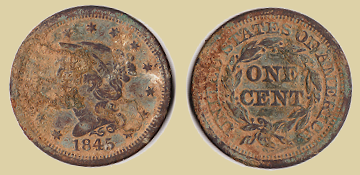
|
VDI 83 |
1845 large cent provided for reference. Coin shows little
wear, and should clean up nicely when the surface dirt is removed.
Point is to show weight loss of 6% even with minor wear.
|
|
Large Cent
|
|
weight (g) ref/act/loss:
|
| 10.89/10.20/6.39% |
| dug 6/28/09, loc C |
|
|
|
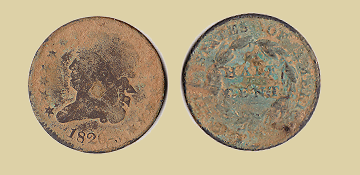
|
VDI 78 |
1826 half cent. Hopefully will be able to get the caked-on dirt
off this one as well. For comparison with following.
|
|
Half Cent
|
|
weight (g) ref/act/loss:
|
| 5.44/5.00/8.09% |
| dug 6/28/09, loc C |
|
|
|

|
VDI 76 |
Another 1826 half cent. Great for providing reference to the above.
VDI never rang above 77 in testing, where the above did touch 80. So we'll
call about 2 points of VDI loss from the wear and tear. Note 17% weight
loss off the reference for the worn coin.
|
|
Half Cent
|
|
weight (g) ref/act/loss:
|
| 5.44/4.48/17.65% |
| dug 4/16/09, loc B |
|
|
|
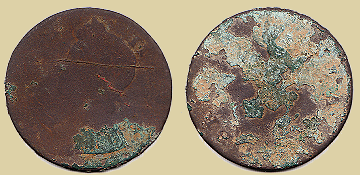
|
VDI 61 |
This coin seems likely a period counterfeit. One would expect a VDI
of around 80 for a pure copper. Debasing the coinage with
base metal alloys was a common counterfeiting technique, and the low VDI
seems to give it away. Weight loss seems consistent with wear and tear
(or intentional faking of a worn coin, also a common practice).
|
|
George II Copper
|
|
weight (g) ref/act/loss:
|
| 9.96/7.66/23.09% |
| dug 3/30/09, loc A' |
|
|
|
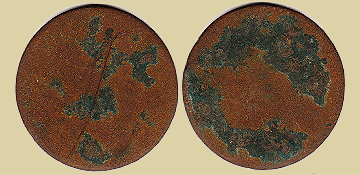
|
VDI 61 |
This copper has no identifiable markings. Like the previous one,
VDI indicates counterfeit base metal alloy. Given its weight, I would
expect to see something on it. Perhaps it was blank all along.
I have some pretty worn coppers, but none purely flat like this. Who knows?
|
|
Unknown Copper
|
|
weight (g) ref/act/loss:
|
| 9.96/8.22/17.47% |
| dug 04/09, loc A |
|
|
|
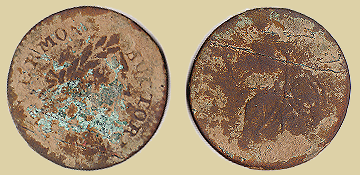
|
VDI 77 |
Consistent with 1787 "Britannia" Vermont copper, VDI strikes
me as a touch low, but consistent with mostly pure to pure copper,
possibly reflecting wear and tear.
Rang as 86-88 in the field.
As I understand it, colonial mints had little quality control over
their source copper.
|
|
Vermont Copper
|
|
weight (g) ref/act/loss:
|
| --/7.07/-- |
| dug 6/08/09, loc A |
|
|
|
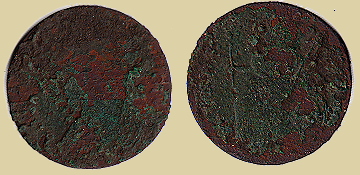
|
VDI 83 |
Consistent with a CT or VT copper. VDI indicates genuine copper
and no debased regal halfpenny. Not much to go on except an "IN" on
the reverse consistent in location with "INDE" found on many of these
domestic coppers. Perhaps an ammonia bath is in order.
|
|
Colonial Copper
|
|
weight (g) ref/act/loss:
|
| --/7.35/-- |
| dug 6/08/09, loc A |
|
|
|
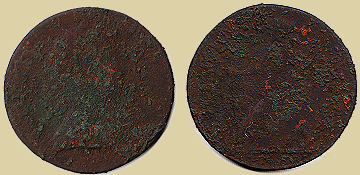
|
VDI 81 |
Right facing bust and seated Britannia consistent with George III
copper. VDI and weight consistent with genuine regal mintage. If some
lettering cound be recovered, it could possibly be identified as a
colonial copper instead, but no lettering has been recovered yet.
|
|
George III Copper
|
|
weight (g) ref/act/loss:
|
| 9.96/8.80/11.65% |
| dug 6/09/09, loc A |
|
|
|
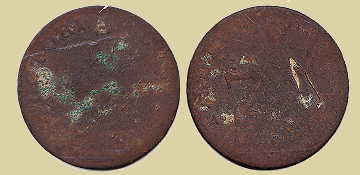
|
VDI 78 |
Consistent with a CT or VT copper, sort of. "TORI" recovered
on obverse consistent with "AUCTORI" on some of these coins. "INDE"
recovered on reverse consistent with domestic issue colonial coppers.
However, the position of the arm relative to the "N" in "INDE", and
the details of the branch it is holding are not consistent with any
pictures of these coins that I've found. "TORI" would appear in upper
left of obverse if normal (180 degree) relation to reverse is true
in these coins.
|
|
Colonial Copper
|
|
weight (g) ref/act/loss:
|
| --/7.55/-- |
| dug 6/10/09, loc A |
|
|
|
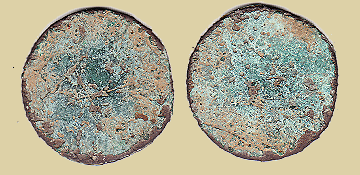
|
VDI 82 |
What a treasure. The 26mm width is inconsistent with any large
copper I'm aware of, except for chain-type US large cents, which weigh
twice as much. Colonial and regal halfpennies are generally 29mm.
Farthings and US halfpennies are smaller, while other US large cents are
larger. VDI indicates genuine copper.
|
|
26mm Copper
|
|
weight (g) ref/act/loss:
|
| --/6.41/-- |
| dug 6/10/09, loc A |
|
|
|

|
VDI 76 |
Consistent with a George III copper. 34% weight loss seems light
for the amount of wear. VDI seems a tad light as well, but rang up to 80.
Tough to say between counterfeit and genuine, tho I am leaning towared
the former, based on comparison with the other presumed genuine and
conterfeit coins.
|
|
George III Copper
|
|
weight (g) ref/act/loss:
|
| 9.96/6.53/34.44% |
| dug 6/11/09, loc A |
|
|
|
|
| |
- All VDI tests done with a DFX using the stock 950 coil, using
the Deep Silver program. Air test on a 5 inch stack of phone books in
a verified metal-free area. VDI's bounced a few points in some cases;
most consistent number was chosen.
- It has been estimated that anywhere from 30% to "a majority" of
British regal halfpennies (George II, III, et. al.) circulating in the
colonies in the late 18th century were counterfeit (either domestic
or British Isles produced).
- Weights are reference, actual, and percent loss. Reference
weight of 9.96 grams and dimensions of British coppers taken from
Forgotten Coins of the North American Colonies, by Anton,
William T. & Kesse, Bruce. Information on 18th century
counterfeit coppers from ibid. and the
Notre Dame Colonial Coins Project website.
Information and weights on domestic coppers taken from
A Guide Book to United States Coins (aka "The Redbook"),
by R. S. Yeoman.
|
| |

|
| |

|
| |
|
|
|
|